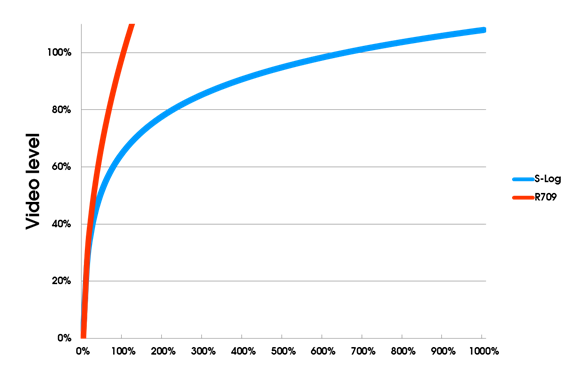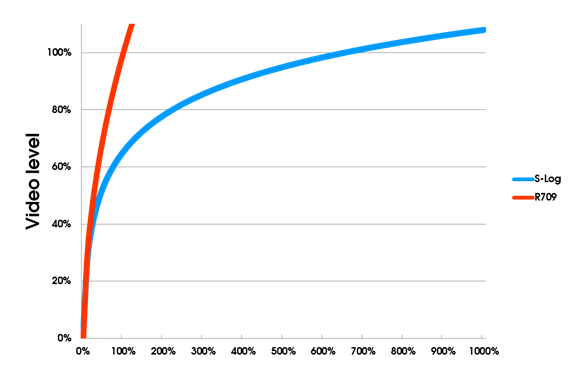
The S-LOG Gamma curve of the Sony PMW-F3 (blue) maintains camera highlights up to 800% of nominal peak white. This is far beyond the capability of conventional Rec.709 gamma encoding (red).
As the much-talked-about PMW-F3 handheld Super 35mm camcorder hits the streets this month, it comes with the promise of S-LOG Gamma, which will be available as an extra-cost upgrade later this year. S-LOG will join the F3’s built-in HyperGamma curves as creative tools for managing high scene contrast. So what can S-LOG Gamma do for your images? How does it differ from HyperGamma? And what are the basic requirements for handling S-LOG Gamma in post? I’m glad you asked.
Regular readers of Pro Video Coalition know that the PMW-F3 is generating considerable attention with some good-looking pre-production tests, some nice Vimeo clips and considerable attention in the press. The camera includes XDCAM EX on-board recording, HD-SDI and dual-link outputs for outboard recording and a 35mm PL lens mount. Available this month, the PMW-F3L camera body will set you back $16,000 MSRP while a kit including three prime lenses, the PMW-F3K will go for $23,000 MSRP. A previous Pro Video Coalition article described the camera’s Super 35mm image sensor. S-LOG Gamma helps capture extended grayscale information from that sensor.
The challenge of handling highlights
Without contrast between highlight and shadow, there is no photography. So photographers are naturally concerned, if not obsessed with the tonal range from deepest black to brightest highlights. In high-contrast scenes, such as exterior noontime shots on a cloudless day, it’s often a challenge to maintain detail simultaneously in the shadows and the highlights. We want neither to crush the blacks nor blow out the highlights.
Conventional video encoding, while great for many applications, is particularly prone to highlight clipping. To protect highlights, video cameras traditionally incorporate Knee and Slope controls. But if one of the three color channels enters the knee region before the others, the result can be unnatural color shifts in the highlight areas. A more comprehensive solution is Sony’s set of HyperGamma curves, identified on the PMW-F3 as Cine 1, 2, 3 and 4. The result is a great-looking image suitable for the conventional, Rec. 709 video workflow.
The optional S-LOG Gamma upgrade is the next step.
S-LOG Gamma
S-LOG Gamma passes the image data through a logarithmic function that preserves highlights right up to the limit of the image sensor, which for the PMW-F3 equals 800% of nominal peak white. This tremendous benefit comes with a tradeoff: a camera image that initially looks flat and lifeless. Without applying a Lookup Table (LUT) to reconvert S-LOG material, the picture will have milky blacks and dull highlights. Experienced DPs have become accustomed to working with these images on set, but clients and producers may freak out. Fortunately, the PMW-F3 S-LOG upgrade can apply the appropriate LUT to the HD-SDI output for an accurate, pleasing image on-set. (Sony’s BVM-L230 and BVM-L231 monitors also incorporate S-LOG to Rec. 709 conversion via internal LUT.)
S-LOG Gamma = Grading in post
Just as S-LOG images require a LUT for on-set monitoring, they require a grading pass in postproduction. This establishes proper grayscale for the target distribution medium, whether digital media, broadcast or film. While HyperGamma images are suitable for news, sports, live productions and projects with minimal post, S-LOG images are only suited for projects where you know the image is destined for color grading.
The S-LOG Gamma camera image before and after color grading.
Further reading
For the technically inclined, Sony offers a comprehensive white paper on S-LOG Gamma. There’s also a previous Pro Video Coalition article devoted to HyperGamma. You can find a detailed description of the F3 in a Special Report in Jon Fauer’s Film and Digital Times.

